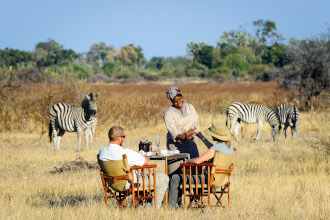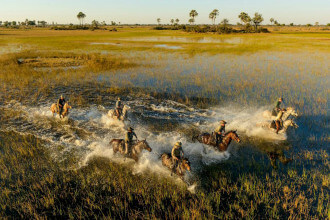The densely-forested Masoala Peninsula contains the largest remaining block of protected rainforest in Madagascar and harbours a wealth of rare and unique species including the stunning red-ruffed Lemur, found only on the peninsula.
The Masoala national park covers 240,000 ha of the peninsula as well as three marine areas. The remote and secluded peninsula can only be accessed by boat across Antongil Bay. This is the wettest place in Madagascar with an annual rainfall exceeding 500cm. The trails can be quite steep and muddy so you need to be physically fit to visit this area! The rainforest teems with life, though with so many places for animals to hide, it can be hard to spot at first. That said, the Masaola Peninsula is one of the most biodiverse places on Earth, with 50% of Madagascar's biodiversity spread across just 2% of its landmass, and simply experiencing it leaves the visitor overwhelmed. Tiny technicolour mantella frogs - Madagascar's version of poison dart frogs - flit through the leaf litter while dazzling day-flying sunset moths glide overhead. This is a wonderful destination for photographers, with white sand beaches and some of the the world's most impressive lowland rainforest.
Combine night and day walks through the primary forest and trips up the river in traditional dug-out
pirogues. Beach activities include snorkelling and guided sea kayaking for a chance to spot bottlenosed dolphins and green turtles. This is one of the world's prime birding locations, with star species including the stunning helmet vanga, the elusive ground-rollers (with all three lowland rainforest species present: pitta-like, scaly-breasted and short-legged) and the incredibly rare Madagascar serpent eagle. For a few months in the first half of the year, hundreds of splendid tree orchid species flower in the canopy, 85% of which are unique to Madagascar. Beyond birds and botany, this is one of the best places to come on the island to see lemurs. By day you'll spot white-fronted brown and beautiful red-ruffed lemurs (a Masoala speciality). By night you'll look for mouse, dwarf and rare fork-marked lemurs. Though they are very elusive, the lucky night-spotter may even glimpse an aye-aye. With extra long middle fingers, a long brush-like tail and ears like black radar dishes, this nocturnal lemur is one of the oddest animals on Earth. You'll at least see tell-tale holes in the trunks of large trees where aye-ayes have chewed into the wood to feed on beetle larvae. Night walks are also the best time to spot the fantastic leaf-tailed geckos and the many chameleon species, with more here than anywhere else in the world.
Masoala National Park: where to stay
Masoala Forest Lodge
Remote and secluded, wild and exotic, eco-friendly
Masoala Forest Lodge comprises 6 wooden tree-houses on stilts set on the edge of primary rainforest. Various activities are available, including yoga retreats.
For a summary of the
Best places to stay in Masoala National Park, please follow this link.
 2023 Guest Reviews
2023 Guest Reviews
 Kruger Walking Safari
Kruger Walking Safari
 Botswana Trip Report
Botswana Trip Report
















